
Stone With Holes On A Beach Free Stock Photo Public Domain Pictures
The smooth rocks feel so wonderfully healing to the touch! This article includes various types of basalt, septarian brown stones, limestone, granite, gabbro, diorite, gneiss, schist, sandstone, siltstone, mudstone, geodes, chalcedony, and agate. If you don't see a match for the stone you've found here, you might find it here: Common Beach Stone.

Relax Big rock with hole made by the sea on the beach YouTube
This depends largely on the beach, but I've found that the ends of narrow areas in rock reefs are great. You just need to be aware of the waves to avoid getting wet.. The best way to tell is to look for sharp edges on the hole in the rock. Very large holes with no other holes are also a bit suspicious, but some folks do grind down the rest.
This rock I found on the beach has a hole in it. r/mildlyinteresting
Frequently, there is evidence for more than one type of organism occupying the same stone. One of the bivalve molluscs that creates holes in stones and thick oyster shells is the Wrinkled Rock Borer Hiatella arctica (Linnaeus). Like the piddock, this species can actively excavate a burrow in soft stone for shelter and protection although unlike.

Holes on the Rock Filled with Ocean Water in an Australian Shoreline Stock Image Image of
Vesicle. Vesicles are gas bubbles in lava that has solidified. Lava that is full of bubbles is said to have a vesicular texture. The word comes from the Latin for "little bladder." Vesicles that fill with minerals are called amygdules; that is, if a vesicle is like a mold, an amygdule is like a cast. 11.
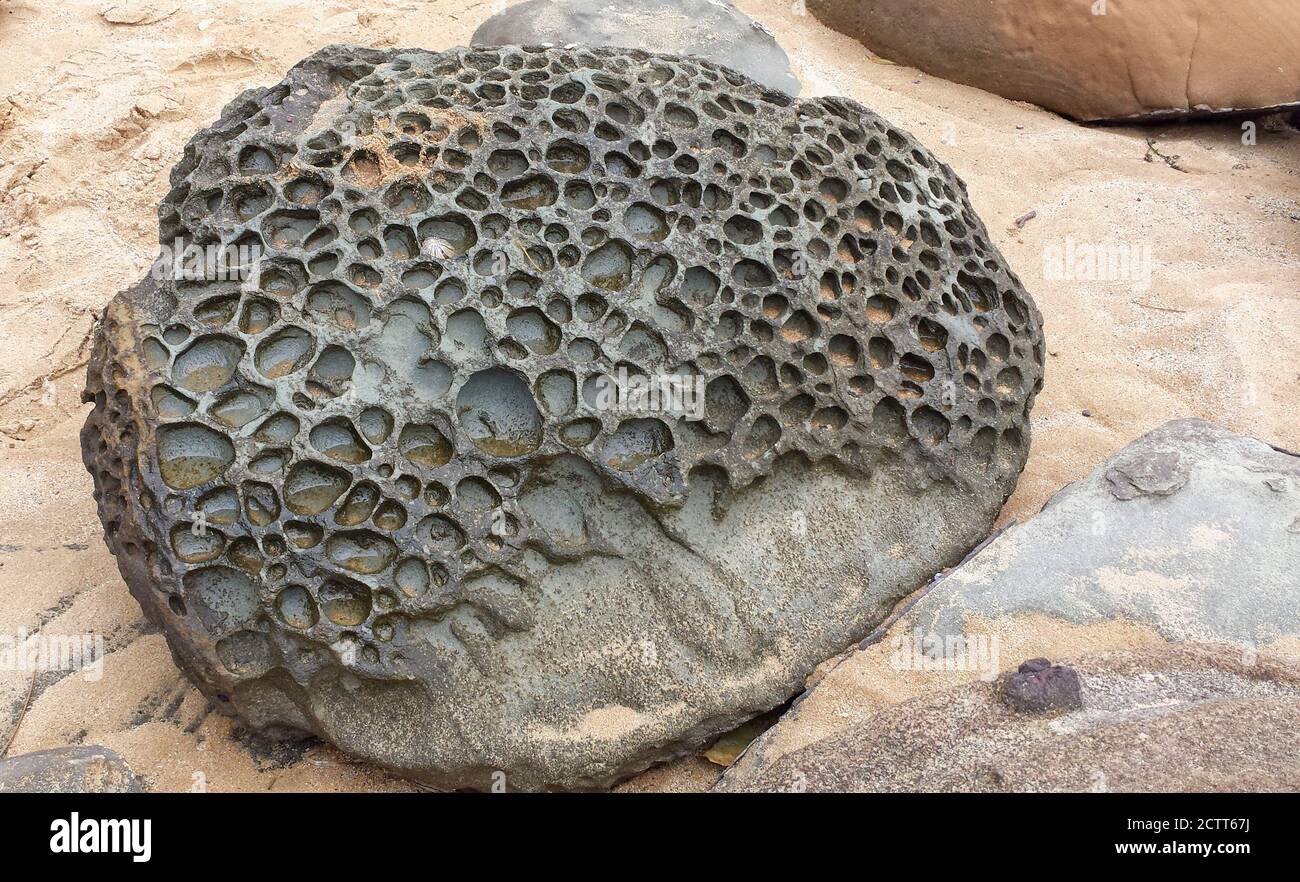
A Large Rock with Many Holes Found on Beach Stock Photo Alamy
The first group of rocks with very obvious holes found on the beach are called hag stones, Adder stones, Odin stones, holey stones, witching stones, chicken gods, and so on. Holes are produced with boring mollusk. The second group of rocks is igneous volcanic rocks like pumice and scoria. What Causes Small Holes in Rocks
/close-up-of-rocks-at-beach-560515091-59de7c3baad52b001091ff7b.jpg)
11 Types of Holes in Rocks
This is a common process in limestone rocks. The word "coquina" is Spanish for "cockle" and is the name given to the small, burrowing clam that lives in the sand just at the ocean's edge. This is the main shell component to the rock. The scientific name for the clam is Donax variabilis, as the shells of the clams can be various colors.
. What to Do When on the Beach
11 Incredible Rocks, Gems, and Crystals Found in the Ocean (With Photos) The ocean is home to many treasures, including a variety of gems and crystals. Pearls, quartz, and ocean jasper are just some of what can be found beneath the waves and along the beach. These natural beauties come from different parts of the ocean, from shallow waters to.

What causes these holes in this rock I found on the beach? There are shells within the holes
Rhyolite with tiny holes. You are likely to find rhyolite rocks that have tiny holes. They come in many colors, from red, brown, pink, white, or gray. They have a unique banding that forms as Rhyolite cools or hardens. Interestingly, Rhyolite has a bit of quartz, plagioclase, and sanidine, with tiny hornblende and biotite.

'Lucky Stones' stones with naturally occurring holes found on the beaches of Lake Winnipeg
When rockhounding this type of beach stone, look for surfaces on the stone that are shiny when wet, but dull and porous when dry. The most common color of jasper that I've experienced are yellow and tan. Red jasper can also be common on some beaches. Green jasper is probably the rarest color to find.

Identifying the Rocks of Lake Michigan (Geode, Septarian, Agate, and More) Owlcation
Sandworms/Lugworms. Sandworms or lugworms create U-shaped homes down in the sand with two separate openings at the surface—and once their burrows are created, they rarely leave. They can grow to be between three to 12 inches in length, so there's a bit of digging required for each burrow. One opening serves as the feeding "pit" where.

Beach Rock with Hole These holes are made by burrowing mol… Flickr
It's the blow holes (the holes deeper than 1 meter are also known as "solution pipes") that are the namesake of Blowing Rocks Preserve. These holes in the rock, open on both ends, are where the irresistible force of the ocean meeting the immovable object of the Anastasia limestone plays out most spectacularly as water blows from the rocks.

Rocks With Holes Background Free Stock Photo Public Domain Pictures
Some hag stones are the work of a glow-in-the-dark bivalve mollusk called a piddock, sometimes called an angelwing. These critters burrow into rocks as they grow, making themselves tiny caves to.
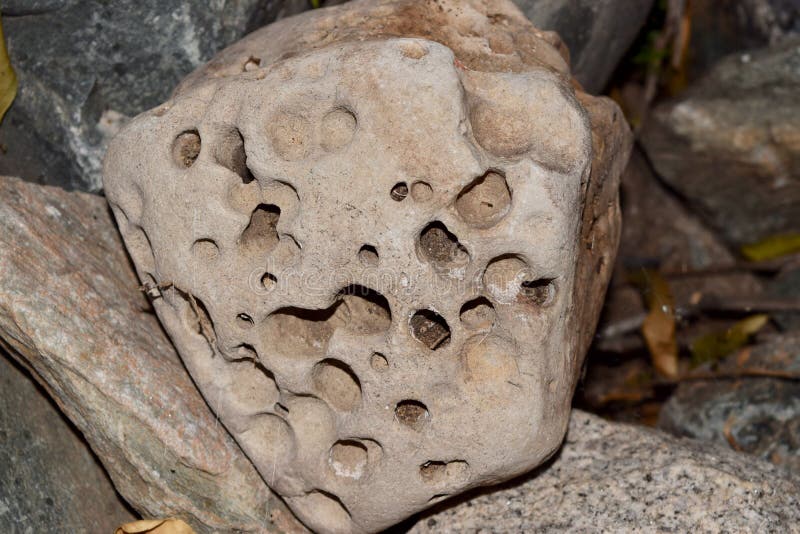
Closeup of a Large Hag Rock with Holes Caused by the Ocean Stock Photo Image of holes, closeup
The beach is one of the best hunting grounds for treasures like petrified wood, fossils, agates, and jasper. The most common rocks to find on the beach are igneous rhyolites, basalt, gabbro, granite, dolerite, obsidian, and pumice; sedimentary dolomite rock, conglomerate, and sandstone; metamorphic rocks like milky quartz, chert, chalcedony.

The Living Drill Bits That Grind Holes in Beach Rocks Bay Nature
Mudstone with Piddocks. Piddock clams. Interesting facts about rock boring mollusks. If you find a chunk of brittle rock with symmetrical holes, chances are it's mudstone. Inside the holes you might find oblong-shaped clams called piddocks. The raspy, rounded end of their shell is used to grind out their burrows, where they spend their lives.
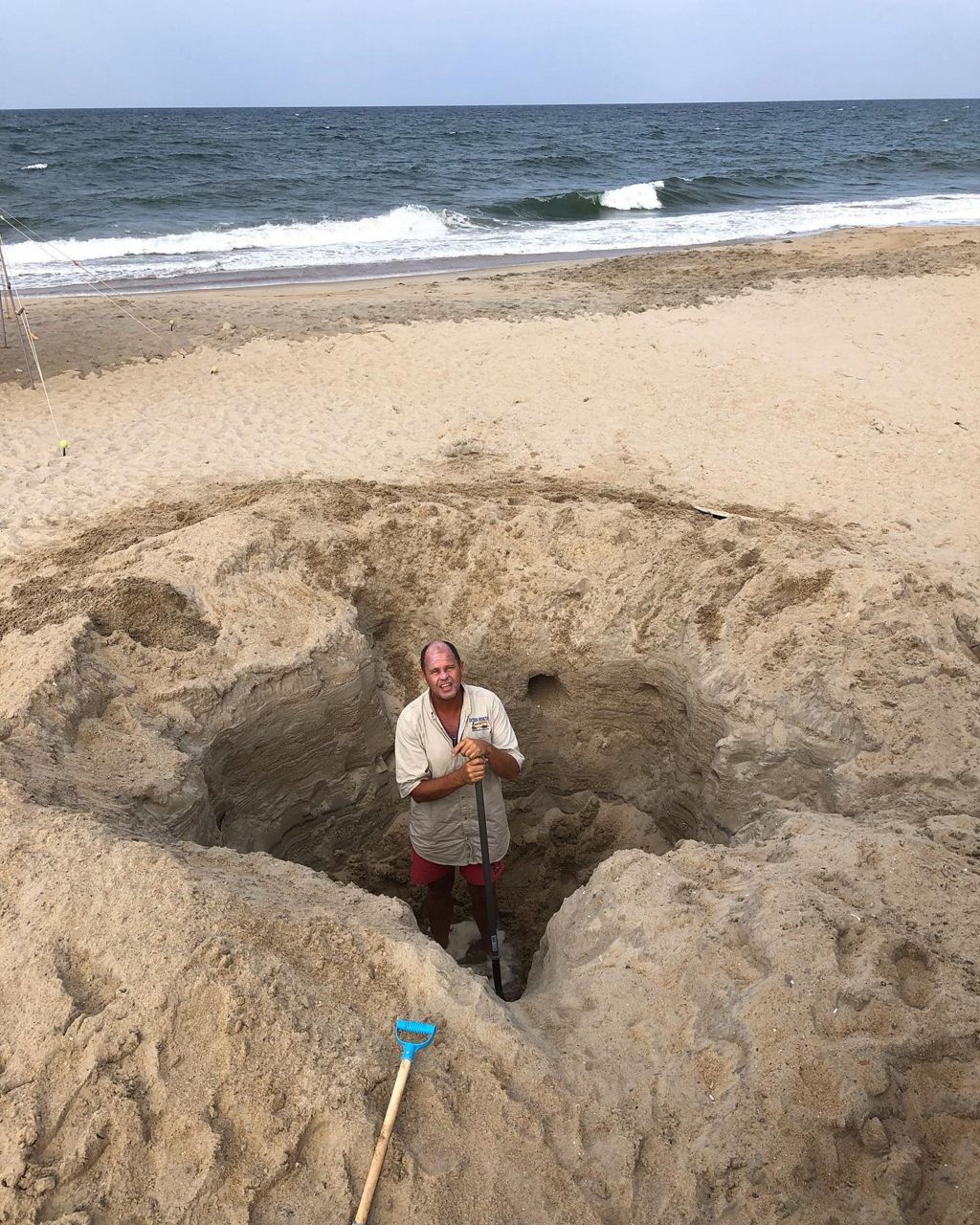
Dangers of digging deep holes on the beach
Rhyolite. Rhyolite is a felsic (silica-rich) volcanic igneous rock with the same mineral content as granite, only unlike granite, it cools fast from the molten rock near or over the surface of Earth's crust (extrusive type).When these magmas erupt, a rock with two grain sizes typically forms. The larger crystals that form just beneath the surface cool at a slower pace and are known as phenocrysts.
Beach is covered with these rocks with holes bored in them. Those little clams dissolve holes in
I found this rock (above) on the beach when I was on holiday in Wales. It has lots of holes, and I couldn't find any other rock with holes like it.
- Ayuda Mayores 52 Novedad 2019
- Alas De Amor Capitulo 26
- Chandal Pantalon Y Sudadera Rosa
- Tarta De Salchichas Para Perros
- Real Madrid Baloncesto Compra De Entradas
- Donde Queda La Montaña Everest
- Amb Pollastre I Més Ciutadella
- Pescado Frito Típico De Cádiz
- Alineaciones De Sociedad Deportiva Amorebieta Contra Nàstic
- Piston Honda Cr 125 2t